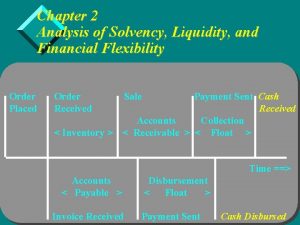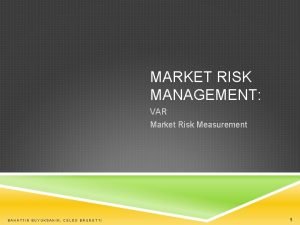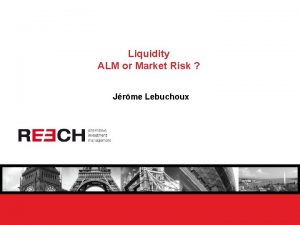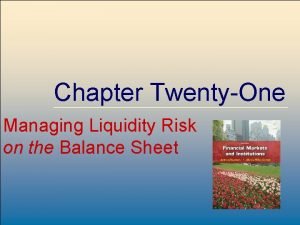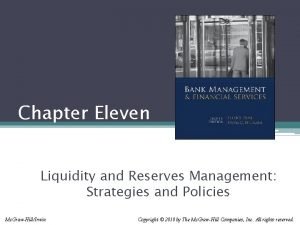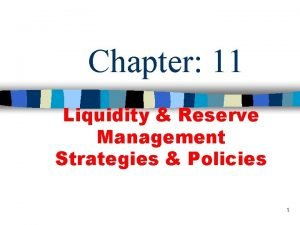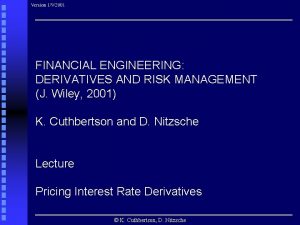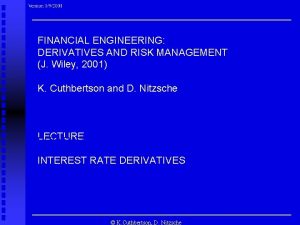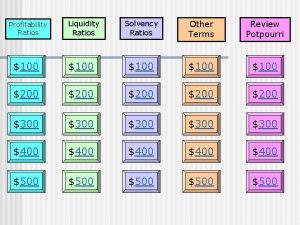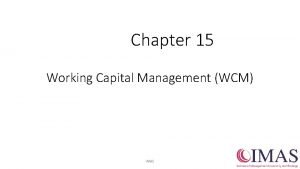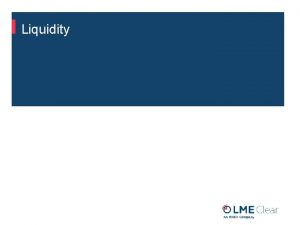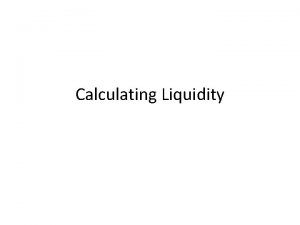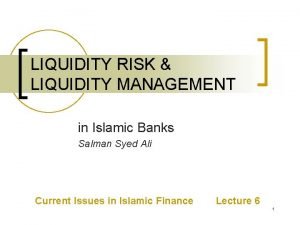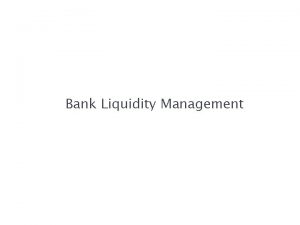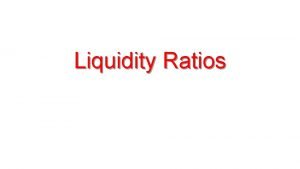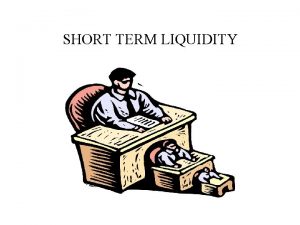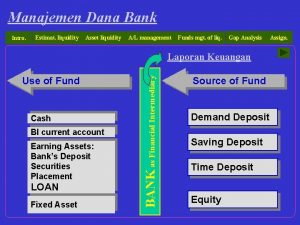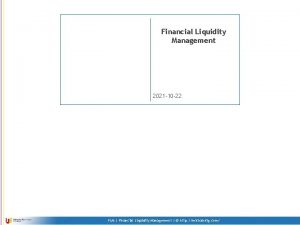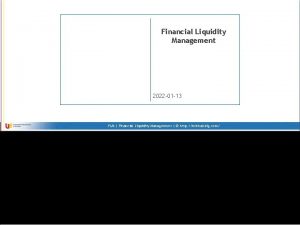Liquidity Risk Chapter 24 Risk Management and Financial




















- Slides: 20

Liquidity Risk Chapter 24 Risk Management and Financial Institutions 4 e, Chapter 24, Copyright © John C. Hull 2015 1

Types of Liquidity Risk l l Liquidity trading risk Liquidity funding risk Risk Management and Financial Institutions 4 e, Chapter 24, Copyright © John C. Hull 2015 2

Liquidity Trading Risk l Price received for an asset depends on l l l The mid market price How much is to be sold How quickly it is to be sold The economic environment As we found in August 2007 transparency is also a factor that affects liquidity Risk Management and Financial Institutions 4 e, Chapter 24, Copyright © John C. Hull 2015 3

Bid-Offer Spread As a Function of Quantity (Figure 24. 1, page 500) Offer Price Bid Price Quantity Risk Management and Financial Institutions 4 e, Chapter 24, Copyright © John C. Hull 2015 4

Bid-Offer Spread (page 502) Risk Management and Financial Institutions 4 e, Chapter 24, Copyright © John C. Hull 2015 5

Cost of Liquidation in Stressed Markets Risk Management and Financial Institutions 4 e, Chapter 24, Copyright © John C. Hull 2015 6

Liquidity-Adjusted Va. R (page 504) Risk Management and Financial Institutions 4 e, Chapter 24, Copyright © John C. Hull 2015 7

Unwinding a Position Optimally (page 505 -506) l l Suppose dollar bid-offer spread as a function of units traded is p(q) Suppose standard deviation of mid-market price changes per day is s Suppose that qi is amount traded on day i and xi is amount held on day i (xi = xi-1−qi) Trader’s objective might be to choose the qi to minimize Risk Management and Financial Institutions 4 e, Chapter 24, Copyright © John C. Hull 2015 8

Example 24. 3 (page 506) l l A trader wishes to unwind a position in 100 million units over 5 days p(q) = a+becq with a = 0. 1, b = 0. 05, and c = 0. 03 s = 0. 1 With 95% confidence level the amounts that should be traded on successive days is 48. 9, 30. 0, 14. 1, 5. 1, and 1. 9 Risk Management and Financial Institutions 4 e, Chapter 24, Copyright © John C. Hull 2015 9

Other Measures of Trading Liquidity Volume of trading per day l Price impact of a trade l Absolute value of daily return divided by daily dollar volume (suggested by Amihud in 2002) Research shows that an asset’s expected return increases as its liquidity decreases l Risk Management and Financial Institutions 4 e, Chapter 24, Copyright © John C. Hull 2015 10

Liquidity Funding Risk l Sources of liquidity l l l Cash and Treasury securities Ability to liquidate trading positions Ability to borrow Retail and wholesale depoosits Securitization Central bank borrowing Risk Management and Financial Institutions 4 e, Chapter 24, Copyright © John C. Hull 2015 11

Basel III Regulation l l Liquidity coverage ratio: designed to make sure that the bank can survive a 30 -day period of acute stress Net stable funding ratio: a longer term measure designed to ensure that stability of funding sources is consistent with the permanence of the assets that have to be funded Risk Management and Financial Institutions 4 e, Chapter 24, Copyright © John C. Hull 2015 12

Examples of Liquidity Funding Problems l l l Northern Rock (Business Snapshot 24. 1) Ashanti Goldfields (Business Snapshot 24. 2) Metallgesellschaft (Business Snapshot 24. 3) Risk Management and Financial Institutions 4 e, Chapter 24, Copyright © John C. Hull 2015 13

Liquidity Black Holes l l A liquidity black hole occurs when most market participants want to take one side of the market and liquidity dries up Examples: l l Crash of 1987 (Business Snapshot 24. 4, page 518) British Insurance Companies (Business Snapshot 3. 1) l LTCM (Business Snapshot 22. 1) Risk Management and Financial Institutions 4 e, Chapter 24, Copyright © John C. Hull 2015 14

Positive and Negative Feedback Trading l l l A positive feedback trader buys after a price increase and sells after a price decrease A negative feedback trader buys after a price decrease and sells after a price increase Positive feedback trading can create or accentuate a black hole Risk Management and Financial Institutions 4 e, Chapter 24, Copyright © John C. Hull 2015 15

Reasons for Positive Feedback Trading l l Computer models incorporating stop-loss trading Dynamic hedging a short option position Creating a long option position synthetically Margin calls Risk Management and Financial Institutions 4 e, Chapter 24, Copyright © John C. Hull 2015 16

The Impact of Regulation l l If all financial institution were regulated in the same way, they would tend to react in the same way to market movements This has the potential to create a liquidity black hole Risk Management and Financial Institutions 4 e, Chapter 24, Copyright © John C. Hull 2015 17

The Leveraging Cycle (Figure 24. 2) Risk Management and Financial Institutions 4 e, Chapter 24, Copyright © John C. Hull 2015 18

The Deleveraging Cycle (Figure 24. 3) Risk Management and Financial Institutions 4 e, Chapter 24, Copyright © John C. Hull 2015 19

Is Liquidity Improving? l l l Spreads are narrowing But arguably the risks of liquidity black holes are now greater than they used to be It is important to have diversity in financial markets where different groups of investors are acting independently of each other Risk Management and Financial Institutions 4 e, Chapter 24, Copyright © John C. Hull 2015 20
 Liquidity profitability and solvency
Liquidity profitability and solvency Key risk indicators template
Key risk indicators template Financial management chapter 8 risk and return
Financial management chapter 8 risk and return Liquidity risk definition
Liquidity risk definition Example of liquidity risk
Example of liquidity risk Liquidity market risk
Liquidity market risk Collateral and liquidity management
Collateral and liquidity management Liquidity and reserve management
Liquidity and reserve management Business risk vs financial risk capital structure
Business risk vs financial risk capital structure Purchased liquidity management
Purchased liquidity management Balanced liquidity management strategy
Balanced liquidity management strategy Liquidity indicator approach
Liquidity indicator approach Financial engineering derivatives and risk management
Financial engineering derivatives and risk management Financial engineering derivatives and risk management
Financial engineering derivatives and risk management Financial engineering derivatives and risk management
Financial engineering derivatives and risk management Credit risk market risk operational risk
Credit risk market risk operational risk Plastic limit formula
Plastic limit formula Liquidity profitability and solvency
Liquidity profitability and solvency Liquidity planning and managing cash assets
Liquidity planning and managing cash assets Liquidity profitability and solvency ratios
Liquidity profitability and solvency ratios Drags and pulls on liquidity
Drags and pulls on liquidity
